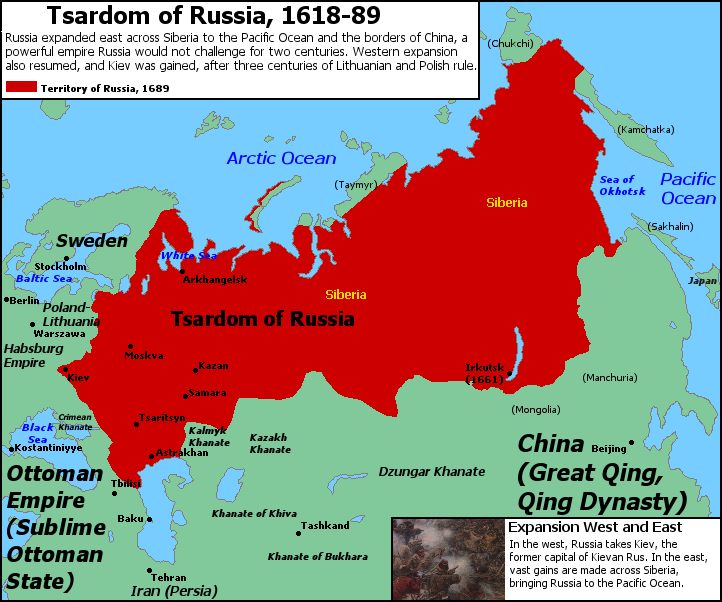

Tsardom of Russia, 1618-89
Russia expanded east across Siberia to the Pacific Ocean and the borders of China, a powerful empire Russia would not challenge for two centuries. Western expansion also resumed, and Kiev was gained, after three centuries of Lithuanian and Polish rule.
Expansion West and East
In the west, Russia takes Kiev, the former capital of Kievan Rus. In the east, vast gains are made across Siberia, bringing Russia to the Pacific Ocean.
Comments
China
Like Russia with its Times of Troubles and then renewal under the Romanovs, China had undergone a period of decline and renewal in the 17th Century. The Ming Dynasty that ruled China was in steep decline with indolent emperors, a faltering economy, famines caused by drought and cold weather, and peasant uprisings. Unlike Russia, which recovered on its own, renewal for China came from outside. To the northeast in what is now Manchuria, the Jurchens, whom the Chinese regarded as barbarians, united under a dynasty of dynamic leaders and expanded into Korea, Mongolia, and China itself. As the leaders grew in power, they declared their dynasty the Qing ("Pure"), their state as Great Qing (called the Qing Dynasty in English), and renamed their people the Manchu. Over several decades, the Qing conquered all of China, Tibet, and nearby areas. They ruled their empire from China but reserved Manchuria as their special homeland.
It was during this period of Qing rise and expansion that the Russians (with Cossacks) showed up in eastern Siberia on the borders of Manchuria. Starting in the 1640s, Russian explorers scouted the Amur region of northern Manchuria, followed by occasional waves of military forces that built forts there and Russian settlers who wanted to exploit and farm the area. Agriculture was practical in the Amur region, unlike in Siberia, increasing Russian interest in the region.
The Russians were countered by the Qinq, who claimed the Amur region. Skirmishes and battles occurred over four decades, while the main Qinq attention was on their ongoing conquests in China and other places. Finally, in the 1680s, reinforced Qinq forces defeated the Russians several times and drove them out of the Amur region. The 1689 Treaty of Nerchinsk between China and Russia affirmed the area belonged to the Qing. In return, Russian traders were allowed access to China, which the Russians now regarded as more valuable than the clearly-indefensible Amur region. This would remain the status quo between the two empires until the middle of the 19th Century, when the Qinq were in decline but the Russians had greatly grown in power.
More to the Story: The Albazinian Cossacks
While most Russians withdrew from the Amur region following the Qinq victories of the 1680s, a small group of Cossacks there decided to join the Qing. The Qing sent them to Beijing and made them the Oros Niru unit of the Chinese imperial guard. They intermarried with the Chinese and their descendants spoke Chinese rather than Russian, but they remained Orthodox Christians. There are about 250 Albazinians in China as of the early 21st Century.